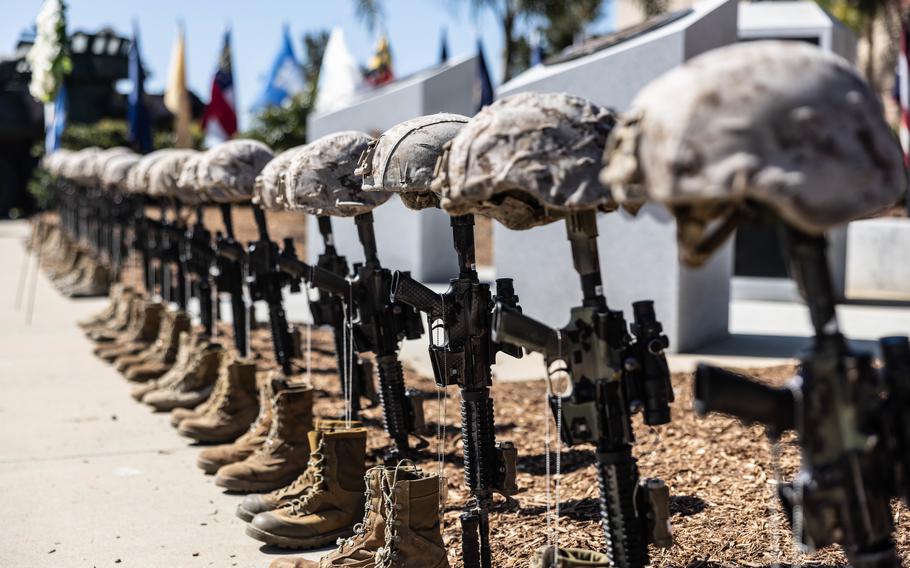
Congress is back in session and with the results of the 2024 election behind us, members have a long list of items that need to get done before the new year. One item that should be added to the top of that list is a repeal of the 2002 and 1991 authorizations for the use of military force (AUMFs). (Cameron Hermanet/U.S. Marine Corps)
Congress is back in session and with the results of the 2024 election behind us, members have a long list of items that need to get done before the new year. One item that should be added to the top of that list is a repeal of the 2002 and 1991 authorizations for the use of military force (AUMFs).
Repealing the pair of AUMFs should be a no-brainer. Keeping the authorizations on the books gives any president the legal authority to surge troops to the Middle East, even though decades have passed since the authorizations were drafted. Both the Iraq War and Gulf War are now over, meaning the AUMFs have overstayed their welcome in U.S. Code. Most importantly, the AUMFs are not used as the sole domestic legal justification for any active operations by the United States.
The 2002 and 1991 AUMFs are also not the only tool in the toolbox. Even if the AUMFs are repealed, the president can use Article II of the U.S. Constitution as legal justification if force is warranted to defend the United States. If he needs additional domestic legal authority, he can make his case to Congress, as Presidents have historically done in times of crisis.
While the 2002 AUMF has not been used as sole legal justification for over a decade, during his first term President Donald Trump argued that the 2002 AUMF “reinforces” the authority to use force against ISIS in Iraq and asserted that the 2002 AUMF authorizes force to address both “threats to, or stemming from, Iraq” in “Syria or elsewhere.” His administration also took an expansionist view of the 2002 AUMF to justify killing Iran’s Islamic Revolutionary Guard Corps Maj. Gen. Qassem Soleimani. Congress responded to the Trump administration’s expansionist view of the 2002 AUMF and the Soleimani killing by passing a war powers resolution, directing the president to cease hostilities against Iran. Trump vetoed it.
These expansionist interpretations of the 2002 AUMF demonstrate the urgent need for Congress to repeal the 2002 and 1991 AUMFs before the new administration enters the White House.
While repealing the 2002 and 1991 AUMFs is popular across the aisle, the repeal effort has stalled in Congress. In 2021, the House of Representatives voted 268-161 on a bill sponsored by Rep. Barbara Lee, D-Calif., to repeal the 2002 AUMF. Unfortunately, since the repeal passed the House last Congress, the House will need to vote again on any repeal.
While the Biden administration has fumbled many foreign policy decisions, one that they got right was by supporting a separate bill sponsored by Sens. Tim Kaine, D-Va., and Todd Young, R-Ind., to repeal the 2002 and 1991 AUMFs. The endorsement led to long awaited action in the Senate on the repeal. In 2023, the full Senate voted to repeal the AUMFs in an overwhelming 66-30 vote.
Although the repeal is popular on both sides of the aisle, Republican leadership has failed to schedule a vote to repeal it. The reasoning? House Foreign Affairs Chairman Michael McCaul, R-Texas, argued during a hearing in September that Congress should “repeal and replace all the AUMFs with a new, more limited authorization scope to the terror threats that we face today.”
The argument that all AUMFs should be repealed and replaced together right now is a faulty one. Repealing the 2002 and 1991 AUMFs seem to have broad bipartisan consensus. However, repealing other AUMFs, such as the 2001 AUMF, does not. Since the 2001 AUMF is still used as domestic legal authority, the parameters of a new AUMF, if there will be one, is far more complicated. It is also unclear what threats McCaul alluded to, and why a president would need a reauthorization of the 2002 and 1991 AUMFs, considering the United States does not currently use them as sole legal justification, and didn’t do so even under the first Trump administration.
It’s important to remember that opposing the repeal is actually supporting more wars without congressional oversight. Stopping the repeal from coming to the House floor is voting for a president to have the power to surge thousands of our brave men and women in uniform into the Middle East, with zero input from their elected members in Congress.
One way that Congress could repeal the 2002 and 1991 AUMFs is by attaching a repeal provision to the National Defense Authorization Act. While the final bill is still being negotiated by leadership behind closed doors, there is still time to add the repeal to the base text of the bill. But if that fails, members can still introduce an amendment to the bill on the House and Senate floor to repeal the pair of AUMFs. Members supportive of the repeal are in a unique position because of the current slim majorities. Since the repeal is so popular, these members on both sides of the aisle may demand that the repeal be included in the bill, or they will vote against the NDAA, preventing its entire thousand-page contents from becoming law.
With the new year quickly approaching and a new government forming in Washington, now is the time for Congress to stop dragging its feet on repealing the 2002 and 1991 AUMFs. Doing so would ensure that no future president has the ability to unilaterally send our brave men and women to war based on decades-old and strategically irrelevant authorities that should have been sunset long ago.
Demri Scott Greggo is a Contributing Fellow at Defense Priorities.